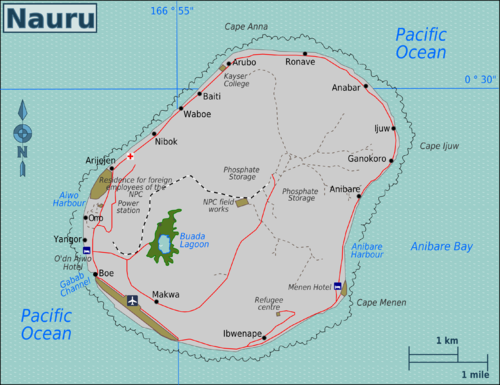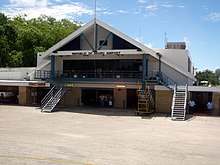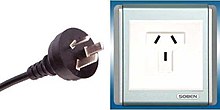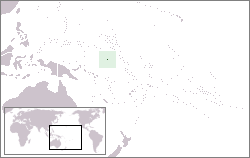| Nauru has been nominated for featuring on the main page as Off the Beaten Path. We may have failed to notice some minor glitches in the article. Please plunge forward and help improve it further before it hits the main page. |
Nauru is a small island in the South Pacific Ocean south of the Marshall Islands and is the world's third-smallest country — only Monaco and the Vatican City are smaller. An off-the-beaten-track destination if there ever was one, Nauru is also the least visited country in the world. The remoteness, and the fact that much of the island is a charmless open phosphate mine, are two strong reasons for this.
Understand
History
In the local language the island is known as Naoero, though the name is of unknown origin. Nauru is a simplification of the name by the English colonizers. The island has also been known by the names Pleasant Island, Island Gambo, Nawodo and Onawero.
Nauru was first settled around 3,000 years ago by twelve Micronesian and Polynesian peoples. Those twelve tribes divided the island into twelve parts; today this is symbolized by the twelve-pointed star in Nauru's national flag (the yellow line represents the Equator and the blue space the Pacific Ocean). The original inhabitants lived on fishing and even turned the lagoon in the middle of the island into a fish farm.
The first European to set foot on the island was the British commander John Fearn in 1798. The natives had a good relationship with the European ships whom they traded with. Occasionally, deserting sailors settled on Nauru. The island was devastated by a civil war between 1878 and 1888, after which it was annexed by the Germans. During the three-decade period as part of the German Pacific Territory, a king was appointed to rule the island, and the first missionaries arrived.

Mining of Nauru's phosphate deposits, which occupied about 90% of the island, began in the early 20th century under a German-British consortium. During World War I, the island was occupied by Australian forces and became a dependent territory. Briefly occupied by Japan during the World War II, Nauru was recovered by Australia afterwards and achieved independence in 1968. In the 1980s, phosphate exports briefly gave Nauruans one of the highest per capita incomes in the Third World. As of 2008, most of Nauru's revenue came from the export of phosphate to Australia, South Korea and New Zealand as well as other countries. The industry is controlled by the Nauru Phosphate Corporation (NPC). It is anticipated that the phosphate reserves will be completely exhausted before 2050. The sale of fishing licences the other major revenue raiser. Countries such as Australia and Taiwan provide substantial development cooperation funding. Despite this, the unemployment rate currently stands at 90%.
In 2001 the container ship Tampa rescued several hundred asylum seekers from a sinking Indonesian vessel and attempted to deliver them to Christmas Island in the Indian Ocean, which is an Australian Federal Territory. In what was labelled The Pacific Solution, the Australian Government established an Off Shore Processing Centre (OPC) on Nauru where these people were housed, pending assessment of their claims to be refugees, in exchange for Australian aid to Nauru. The OPC was closed in early 2008, but was reopened in 2012.
Other than these, also tourism could in the future be an additional source of income for the Nauruans. However, this would require better tourism infrastructure and transportation links.
Climate
| Nauru | ||||||||||||||||||||||||||||||||||||||||||||||||||||||||||||
|---|---|---|---|---|---|---|---|---|---|---|---|---|---|---|---|---|---|---|---|---|---|---|---|---|---|---|---|---|---|---|---|---|---|---|---|---|---|---|---|---|---|---|---|---|---|---|---|---|---|---|---|---|---|---|---|---|---|---|---|---|
| Climate chart (explanation) | ||||||||||||||||||||||||||||||||||||||||||||||||||||||||||||
| ||||||||||||||||||||||||||||||||||||||||||||||||||||||||||||
| ||||||||||||||||||||||||||||||||||||||||||||||||||||||||||||
A small, flat island almost exactly on the Equator, Nauru is a textbook example of tropical climate. The temperature is constant around the year, with even the record lows and highs per month staying within a couple of degrees. The number of average rainy days varies from 16 in January to 9 in May and June.
Nauru is best avoided during the cyclone/rain season, which is from November to February. Even if you wouldn't encounter a cyclone, the sky is constantly cloudy and torrential rains and thunderstorms are frequent during this time of the year.
Terrain
There are a few "sandy" beaches but most of the shallow area around the island is coral reefs. Most of the interior of the island is worked-out mining land, which is to be rehabilitated. The only inland body of water is the lagoon.
Get in

The Australian offshore detention centre operating on the island means that there will be a lot of Australian government staff staying at the island's two small hotels and filling seats on the flights to and from Nauru (especially the direct flight to and from Brisbane). This, in combination with the visa requirement, means that you probably should plan and book your trip a few months ahead.
Entry requirements
All foreign visitors require a valid passport and proof of hotel booking or local sponsor in order to enter Nauru. A free visa on arrival is available to citizens of the Cook Islands, Fiji, Israel, Kiribati, Marshall Islands, Micronesia, Niue, Palau, Papua New Guinea, Russia, Samoa, Solomon Islands, Taiwan, Tonga, Tuvalu and Vanuatu. Citizens of other countries require an advance visa. There have been rumours on the Internet that you can get in for up to three days without getting a visa, but that is not accurate.
You can apply for a visa from:
- Nauruan visitors office, ☏ +674 5573133.
- The Nauruan Press Office at the United Nations, ☏ +1 212 937 0074.
Alternatively you can send an e-mail to principal.immigration@naurugov.nr or visa@naurugov.nr. It may take a long time for the visa application to be processed, so you should send your application well ahead of your intended trip. A tourist visa reportedly costs AUD 100. If you are a journalist and intend to work on Nauru you will need a journalist visa, costing AUD 200, although if you are going to report about the Australian detention centre on the island you might need to fork out AUD 8000, due to a 2014 decision by the Nauruan government. Applications for journalist visas should be directed to: Joanna Olsson, Director of Government Information Office: joanna.olsson@naurugov.nr.
You will be sent a card that you need to fill in and return together with a copy of your passport. The visa fee is paid upon arrival in Nauru. At this time you will have to hand in your passport to the officials to be registered. The passport will be returned to you the next day.
If you're transiting through the American territories (e.g. Guam) on your journey to Nauru, you might need a transit visa or an ESTA, depending on your nationality.
Customs regulations
Passengers may bring in to Nauru:
- 400 cigarettes or 50 cigars or 450g of tobacco
- three bottles of spirits
- a small quantity of perfumes for personal use
- a small quantity of audiovisual products
Drugs, explosives, weapons and porn may not be imported.
By plane

As of March 2016, the national carrier, Nauru Airlines (formerly known as Our Airline and Air Nauru), flies to Nauru from Brisbane, Nadi and Honiara. Flights are rather irregular, with each destination being served one to three times a week.
The 1 airport is located in the Yaren district in the southwest of the island and is where virtually everyone arrives to and departs from Nauru.
By boat
Neither of the two ports in Aiwo and Anibare can accommodate passenger traffic or yachts; they are used for export of phosphate or by local fishermen. As the water is shallow near the coast, larger ships must anchor off shore.
Get around

Every year, there are on average 200 tourists in Nauru, so it has the honor of being the least touristed country in the world. Crowds aren't a problem at all. There's hardly any public transportation, so your best bet to get around would be in a rented vehicle; car, scooter or bike. Other alternatives are by foot (not very pleasant in the tropical heat and humidity) or hitchhiking, which is quite common on the island.
The hotel may or may not send a car to pick you up at the airport; in the worst case you'll have to walk.
By public transport
There is a community bus which travels around the island every hour or so during the day. Also, locals sometimes cling to the cars of the goods train between Aiwo and the inland mining area.
By car

Nauru is so small that it takes less than one hour to drive right around it. The 19km Island Ring Road circles the island and is paved — however this is not the case for most of the inland roads. The airport runway cuts across three of the twenty kilometres of road. The only traffic lights on the island are used to stop the traffic and allow the plane to cross the road to the terminal! This is a favourite souvenir snapshot taken by visitors.
Traffic drives on the left and drivers should be on increased lookout for animals and pedestrians while driving on the beltway.
Cars or bicycles can sometimes be rented from Capelle and Partners, the largest local supermarket. Otherwise you can ask at your hotel or just ask a local. Foreigners need an international driver's license to drive on Nauru. Also, be aware that fuel shortages are not unheard of!
Talk
The official language is Nauruan, a distinct Pacific Island language. English is widely understood, spoken, and used for most government and commercial purposes.
See


- 1 Anibare Bay, Anibare district (along the Ring Road). Here you'll find Nauru's prettiest beach with fine, white sand and surrounded by palm groves.
- 2 Aiwo Harbour, Aiwo district (along the Ring Road). The larger port, used for exporting phosphate. The complex with its conveyor belts on pylons jutting into the sea is pretty impressive.
- 3 Anibare Harbour, Anibare district (along the Ring Road). The smaller harbour is where local fishermen bring their catch to land. Constructed in 2001 with Japanese capital, it's also a popular place for swimming.
- 4 Government buildings, Yaren district (On the strip between the runway and the coast). The government and the president are seated in the Yaren district, near the airport. You can even go and see a parliamentary meeting, as they are usually open to the public.
- 5 Buada Lagoon, Buada district (To get there, take the road opposite the Od-N-Aiwo hotel, follow it until it branches and then go left. The road will lead you straight there.). The only body of fresh water on the island, is a very picturesque spot in the lower middle of the island. The lagoon is surrounded on all sides by dense palm trees and other vegetation. However, the water is dirty and not suitable for swimming in. Still, a nice photo opportunity, and you can walk all the way around the lagoon, as the sealed road circles it.
- 6 The interior of the island. A "moon landscape" as a result of phosphate mining. Locals reportedly call the area Topside. It might not be pretty or what you'd expect of a tropical island, but it's still there.
Do


On land
Nauru is one of the few countries in the world you can walk around the whole perimeters of in a reasonable time. A sealed road goes all the way around the island and drive takes about 25 minutes non-stop. A pushbike ride would take 2-3 hours and a walk maybe 6 hours. There is lots of nice scenery if not much to do and, going from either hotel, Chappelle & Partner department store right at the top of the island in Ewa district makes for a welcome break at halfway around.
When walking around you may see traces from the Second World War, when Japan occupied the island, including remains of Japanese guns, bunkers and pillboxes. There may also be opportunities for some urban exploring of abandoned phosphate mining and transportation facilities in the middle and the west of the island. If you've always wanted to visit a country high point, it's fairly easy to hike up to 1 Command Ridge, 65m above sea level.
If you're into sports, you can watch the local teams battle it out at an Australian rules football match. The national game is played all through Saturday at the 2 Linkbelt Oval sports field.
In the sea
Many beaches on Nauru are shallow and rocky and not very suitable for swimming. Your best bet would be Anibare harbour which also is a great place for swimming and seeing the fishermen bringing in the day's catch. If you want to try some fishing yourself, there's one company you can consult:
- Equatorial Gamefishing Charters, ☏ +674 557 1008, kennetho@eftel.net.au. Boat charter for big game fishing trips. The company has two boats, equipped with fishing equipment and accommodating five persons each. You can catch fish such as yellow fin tuna, marlin, wahoo and sail fish.
Events
These are the most important festivities during the year:
- Independence Day (Jan 31)
- Easter (late March or early April)
- Constitution Day (May 17)
- Angam, the Day of the Return Home (Oct 26)
- Christmas (Dec 25)
Buy
Nauru uses the Australian dollar as its national currency. Cash transactions are the norm; credit cards are rarely accepted. There are no exchange offices in Nauru and the single bank office, Bank of Nauru is usually closed. However in April 2015 the island's first ATM was opened at the Capelle & Partner. You should probably still bring enough Australian dollars in cash for your stay.
Bargaining or tipping are not done on Nauru.
- 1 Capelle & Partner, Ewa district, ☏ +674 557 1000. The only department store and largest business on Nauru island. This is the place to go to for Nauru souvenirs, things you forgot to bring and food, drinks and snacks.
Eat

Most food is imported from Australia and arrives by ship or air, usually once every six to eight weeks. You can find western and Asian (primarily Chinese) food. Because of the tropical climate dishes might not be as heavy and hearty as the original versions. As not all ingredients may be available, dishes are often rather simple.
Since Nauru is an island nation, seafood is very popular in its restaurants. Cooked and smoked hams are also very popular, as meat is one of their main dishes.
Budget
- 1 Fast food kiosk. At Capelle's supermarket, in the north of the island. Serves western fast food.
- 2 Kasuo. Chinese restaurant near the Aiwo hotel. Serves mostly fish and fried rice and noodles.
In addition to these, you'll also find some small inexpensive "eating places", selling Chinese food.
Mid-range
- 3 Reynaldo's (next to the airport terminal). Reynaldo's is a popular name in the list of restaurants and bars in Nauru. It is a local restaurant that offers authentic Chinese cuisines. Also one of the few places on Nauru serving alcohol.
- 4 The Bay Restaurant (Anibare Bay). Specializing in fish dishes, but has pizza and Indian food. Actually located in Anibare, where the local fishing boats arrive. Popular with visitors and locals alike, review sites rank this as the best restaurant on the island.
- 5 Anibare (at Menen Hotel). Seafood and international.
- 6 Oriental (at Menen Hotel). Different Asian food (Thai, Indian, Chinese).
Splurge
- 7 Antinas, Yaren district (near the southern end of the runway). Somewhat upscale seafood restaurant, also serving alcohol.
Drink
- 1 Reef Bar (at the Menen Hotel). The only public bar in Nauru. If you're staying at the other hotel on the island, Od-N-Aiwo, it's rather inconveniently located as it's about 5.5 km away along the ring road. It serves Australian beers and international spirits. The barroom has a couple of pool tables, satellite TV and recorded music. It's lively at the weekends, as Nauruans are paid on Fridays, and quiet on weeknights. New faces will be enthusiastically welcomed by the locals and the expats will usually have a chat, too. No flip flops/thongs (enclosed sandals are OK) and men must wear a collar.
Other than that, restaurants and shops offer soft drinks and some also have alcoholic beverages.
Sleep

There are two hotels, the more expensive Menen on the east of the island and the budget Od'n Aiwo to the west. In addition to these, the supermarket has guest rooms in the north of the island.
- 1 Od'n Aiwo Hotel, Aiwo District (On the coastal belt road, to the west side of the island, directly opposite the road inland to Buada), ☏ +674 444 3701, odinaiwohotel@cenpac.net.nr. The less expensive of the two hotels on Nauru. Popular with backpackers, it has less rooms than Menen but is still the tallest building on the island. The hotel has two restaurants. US$40-80.
- 2 Menen Hotel, Anibare District (On the coastal belt road, to the east side of the island and south of Anibare Bay.), ☏ +674 444 3300, menenhotel@cenpac.net.nr. The Menen is Nauru's largest hotel, boasting 119 rooms and conference facilities for up to 200. It possesses two restaurants and the island's only bar. AUD 95-160, suites AUD 255-500.
- 3 Capelle & Partner Ewa Lodge (Capelle & Partner), ☏ +674 557 1000, cpfinance@eftel.net.au. In Ewa, northwestern Nauru. The supermarket complex offers accommodation seven self-catering apartments and five rooms. AUD 95.
Stay safe

Nauru is a peaceful island and all kinds of crime are very rare. In emergency situations you can call either emergency number (117 or 118) or go to the police station which is near the airport.
Swimming and surfing
Like many other Pacific islands, Nauru is surrounded by a shallow reef with cut-outs through the reef providing access for boats and harbours, and there can be strong currents across the shallow water, moving boats in the harbours, and dangerous marine animals on the reef floor. Ask for advice before venturing into the water.
Stay healthy
Water supply in Nauru is dependent on rainwater collected into tanks from the roofs of houses and from an aging reverse osmosis desalination plant. You should avoid tap water.
- Emergency: 118 or 117
- Nauru General Hospital: 674- 555-4302
Considering its size and remoteness, Nauru has a decent healthcare system. Aside from the rampant problem of obesity among the population, the infant mortality and life expectation numbers are on par with industrialized nations. There are two hospitals on the island, Nauru General Hospital and RON Hospital, both located in the Denigomodu district in the west of the island. However, if you have contracted anything more serious you may need to get transferred to Australia. Needless to say, it's best to have a good travel insurance when visiting Nauru!
The tropical diseases usually encountered in equatorial countries are less of a risk in Nauru, although it's recommended to get a hepatitis B shot. There is a risk of dengue fever, though, so you should protect yourself from mosquito bites.
If you come from a country where yellow fever is endemic or you've visited such a country in the last six days, you need to have proof of yellow fever vaccination.
Respect
Nauru is a Christian country, and Christian values and rules of conduct apply.
- It is illegal to import pornographic material, and the government also blocks access to Internet porn.
- Male LGBT travellers should be aware that male homosexual acts are illegal in Nauru, punishable with 3-14 years in jail (though the law is not always enforced). Open displays of affection between same-sex partners may offend some in Nauru.
- The trafficking of drugs and narcotics of any kind will be punished severely.
- There is one place on the island that you make not take photos of — the Australian "procession centre for illegal immigrants".
Cope

There are three newspapers in both Nauruan and English; Nasero Bulletin, Central Star News and Nauru Chronicle. Foreign newspapers are non-existent and information from the rest of the world comes from the Internet and satellite television and radio — in fact there's no local broadcasting.
As in Australia, the main voltage is 240V/50Hz, and the plugs are Australian too. Bring an adaptor! Brownouts are quite frequent.
Connect
There are a couple of post offices on the island from where you can send mail.
Embassies
There are only two embassies on Nauru; the closest embassies of most other countries are in either Australia or New Zealand.
- Australian High Commission in the Republic of Nauru, MQ45 & MQ43 - NPC OE - Aiwo District, ☏ +674 557 3380, fax: +674 557 3382.
- Embassy of the Republic of China (Taiwan), 1st., Civic Center, Aiwo District, ☏ +674 557 3333, nru@mofa.org.tw. Mo-Fr 06-18.
Telephony
There are public phones and a mobile phone network. Be aware that you may need to buy a SIM card from the local operator Digicel if your home operator doesn't have a roaming contract with Nauru.
Internet
CenpacNet inc. is the only Internet provider, and it also owns the national domain .nr. Moreover it operates the only Internet café on Nauru:
- 1 Cenpac's internet café, Civic Centre, Aiwo district (along the Ring Road).
Other than that, hotels offer computers to get online, though you should inform yourself about the rates beforehand!
Go next
Virtually everyone comes and goes by the local airline and thus your next destination will be Australia or one of the few small Oceanian islands the local airline flies to. When leaving Nauru, be aware that locally produced goods may be subjected to export duties.


